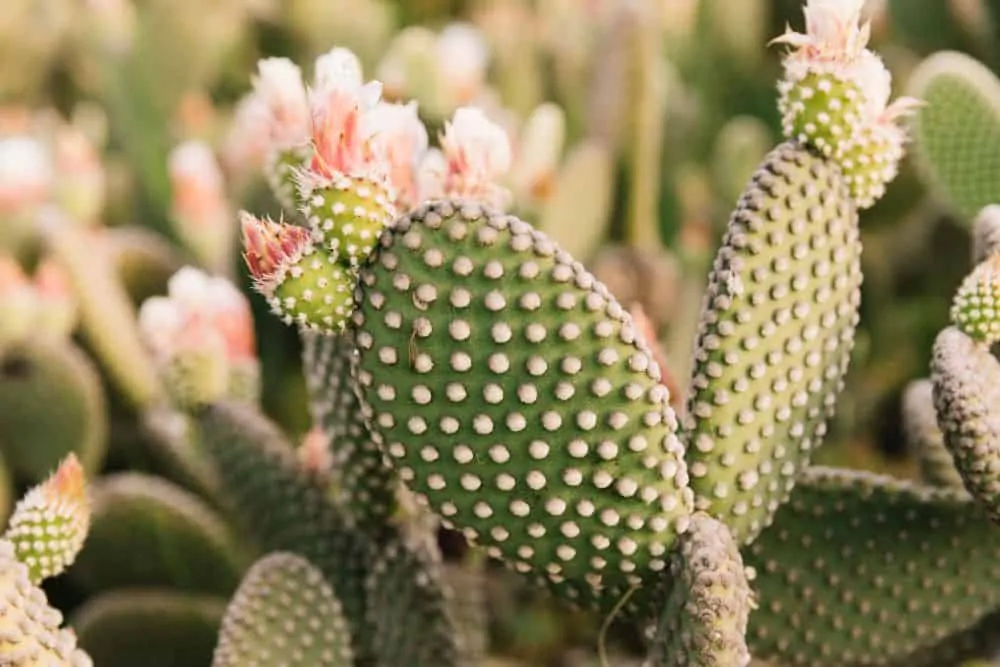


There are times when you want to be one with nature, to be among the plants and trees. But it’s hot and sticky out there… and the bugs! So why not bring the jungle indoors? For that reason, some indoor trees are the right answer for us.
Even though we love small plants, sometimes it requires a tree to feel fulfilled. So, in this article, we will talk about the best indoor trees for your home, what kind of care they require, and how difficult it is to keep them alive. Don’t though about the amount of information. Although it seems a lot to take in, you can always just search for your desired indoor tree throughout the article. Then, find out how you should take care of it and that’s it.
Source: melissa_shapiro_interiors on Instagram
First of all, no list of best indoor trees would be complete without the Fiddle Leaf Fig. With its big, dark green, sometimes referred to as violin-shaped, waxy leaves, it is hands down, the best.
Moreover, the Fiddle Leaf Fig is easy to grow, requiring only bright, indirect light. It does not like a lot of water but also doesn’t like it very dry. Slightly moist soil would be perfect. Even though it is called a fig, it does not produce any fruit.
Source: Lalaland3893 on Instagram
The weeping fig has much smaller leaves than its cousin, the fiddle leaf fig. However, they are teardrop-shaped and have smooth, grayish bark.
This indoor tree needs bright indirect light and prefers its soil on the drier side. Also, it is a little fussier than its cousin, and it may drop its leaves in the fall due to the lower light. So, if you know you are a houseplant killer, make sure you do your homework before hosting this beauty in your home!
Moreover, the weeping fig may live up to its name and “weep” its leaves all over the floor if kept too close to any warm or cold drafts.
Source: plantomia on Instagram
The rubber tree’s leaves are slightly oval and larger than the weeping fig’s. So, it needs bright indirect light, but it can also thrive on the shadier side.
Moreover, this indoor tree prefers moist soil when it’s actively growing and drier soil when dormant. If the leaves wilt during the dormant season, you can slightly increase the amount of water. However, if you water too much, even during the growing season, they may yellow and fall off.
Also, you have heard about the rubber tree plant before when we talked about easy-to-grow houseplants for beginners. In other words, you can grow this indoor tree even if you don’t have gardener’s skills. It is not at all pretentious, so it can help you develop your green thumb.
Source: plantdaddiesofchicago on Instagram
If you have ever seen fields of corn growing, you probably know why this Dracaena is called Corn Plant.
It has long slender leaves, very much like that of a stalk of corn. Unlike the actual corn, this tree can tolerate all levels of light except the full sun.
As the tree grows, it may shed some of the lower leaves, leaving you with a bare trunk and a crop of leaves on the top. Also, very drought tolerant, Dracaena Fragrans will become droopy, and its leaves will turn yellow if overwatered.
Source: herberyboutique on Instagram
If you tend to forget to water your plants, this is one of the best indoor trees for you.
It has a bulbous base that can retain water for weeks. Also, the leaves are long like straps, and even when they don’t get any water, they never look like they are wilting.
The Ponytail Palm is a slow-growing indoor tree, so make sure to buy one that already has a decent heigh. It also makes one of the best office plants to consider for its quirky, cool looks.
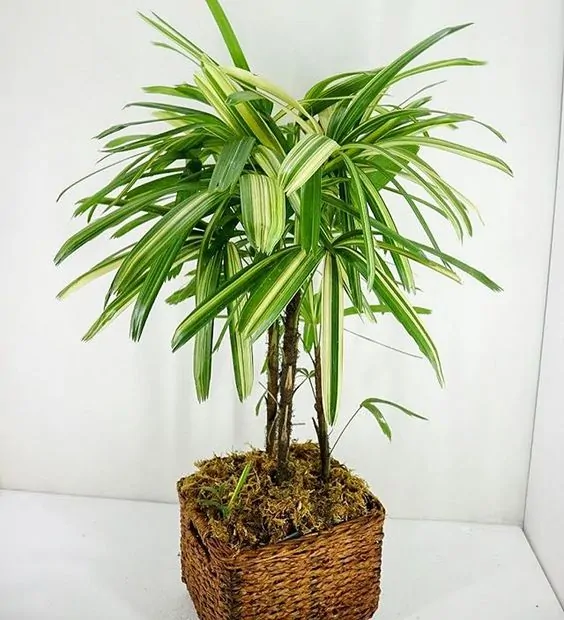
The Lady Palm has a dark green, broad fan-like foliage and may only ever reach a height of six feet tall. However, it is a multi-stemmed indoor tree and will continue to get wider. That’s why it is often called the Bamboo Palm.
Low light or even some interior lighting is all this palm asks for. Also, when the soil feels dry to the touch, water thoroughly.
Source: murals_by_am on Instagram
When it comes to indoor palms, Majesty Palm is one of the most popular choices.
It has long leathery, upright fronds, and it can grow up to ninety feet tall in its natural climate. However, it won’t get that big in your house.
On the other hand, this palm does prefer more humidity than most of the other best indoor trees we hand-picked for you. So, you might want to have it close to the bathroom. Moreover, it likes slightly moist soil and bright, indirect light.
Source: the_sunroom_plants on Instagram
The Dragon Tree has narrow green leaves with red or pink banding on the edges, sitting on top of a long slender branch that would make you think the stems need to be staked up.
Dracaena Marginata is very drought tolerant and will not suffer if you miss a watering or two. Also, it prefers bright light but will tolerate a low light level. However, if there’s not enough light, it will grow much slower and possibly lose the colored banding.
A word of warning, Dracaena is toxic to both cats and dogs. If you want to learn more about gorgeous plants that are toxic (and even lethal), check this guide!
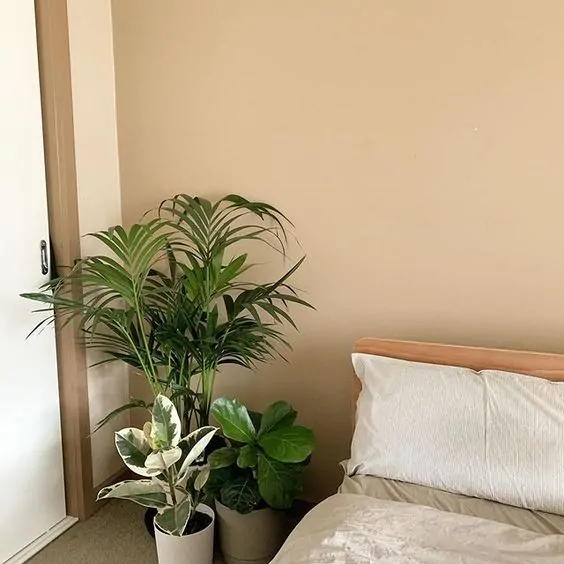
Kentia Palm is a slow-growing tree, but its fronds can reach up to eight feet long. Also, an interesting fact is that with its upright arching, dark green leaves, this palm has been used as an indoor plant since Victorian times.
Moreover, it only needs water when the top of the soil feels dry. This palm prefers low light conditions, as full sunlight will burn its leaves.
Source: ohlalaflowers on Instagram
The Calamondin tree is a hybrid between a kumquat and a mandarin orange. It’s a dwarf orange variety, which makes it perfect for growing indoors.
This orange tree needs as much direct sunlight as you can give it. Don’t forget to rotate it every couple of days, as it will reach for the light. Also, if you want to keep this tree at a specific height, you’d be happy to know that it can make a beautiful bonsai.
So, if you have an interest in citrus trees, here is our guide on how to grow a lemon tree from seed at home!
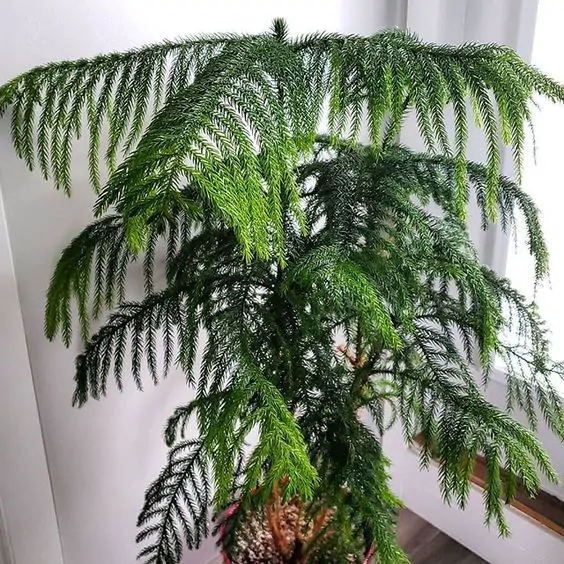
More than likely you will only see these trees available around Christmas, as they make lovely small living Christmas trees. If you want an out-of-the-box Christmas this year and replace the conventional natural or plastic tree, check this guide here on how to choose a Christmas plant to help you decorate your home!
Even though the Norfolk Island Pine prefers full sun, you can alternate that with some lower light every couple of months without much problem. However, it will stretch and become leggy in too little light.
The Norfolk Island Pine is very drought tolerant and will do better if the soil is allowed to dry out between watering.
Source: smartplantapp on Instagram
The Fishtail Palm has large fronds and smaller leaflets that resemble a fishtail. It’s quite ably named if you ask me. Also, this palm can handle full sun to filter partial light. Moreover, it’s very drought tolerant and it is better to allow the soil to dry out between two watering sessions.
This one is considered a clumping palm and will produce plenty of baby pups to replace the older plant.
Source: urbanleafmaine on Instagram
The Umbrella Tree is probably the fastest growing and undemanding tree on this list.
It loves humidity, so the bathroom would be the perfect spot for it. However, it can also adapt to a much drier room of the house without missing a beat. Additionally, allow the soil to dry out between watering and place it in a spot with bright, indirect sunlight.
Also, for more info on this topic, check out our care guide for more info on how to take care of a Schefflera.
Source: greenandmeow on Instagram
Okay, I am sure that the Money Tree caught your attention. Sadly, it does not produce any real currency. However, this tree is used in applications of Feng Shui and has shiny hand-shaped leaves that are said to bring good luck.
If you water your plants often, this is one of the best indoor trees for you. It likes lots of bright light and humidity, so the bathroom is also an excellent choice for this one.
Source: plantsin.t.o on Instagram
Named after the brightly colored birds of South Africa, the Bird of Paradise tree is a huge leafed one, resembling a banana. Sadly, its flowers are very tricky to get to open indoors.
However, the secret to a healthy Bird of Paradise tree is lots of bright light and, if possible, exposure to full sun. Keep a regular watering schedule and don’t allow the soil to get too dry. Then, lots of patience.
It can take anywhere from 3-5 years before it flowers and it will get to be around five or six feet tall.
Source: ruibalsgardenshop on Instagram
I just HAD to throw one more of the ficus family trees in the list. Even though the Alii Ficus is long and shaggy looking, the leaves are very similar to a palm frond.
This tree will handle any light level you throw at it, so you can move it around every time you rearrange your furniture. Also, the Alii Fig is very drought tolerant and only needs to be watered when the top of the soil is dry to the touch.
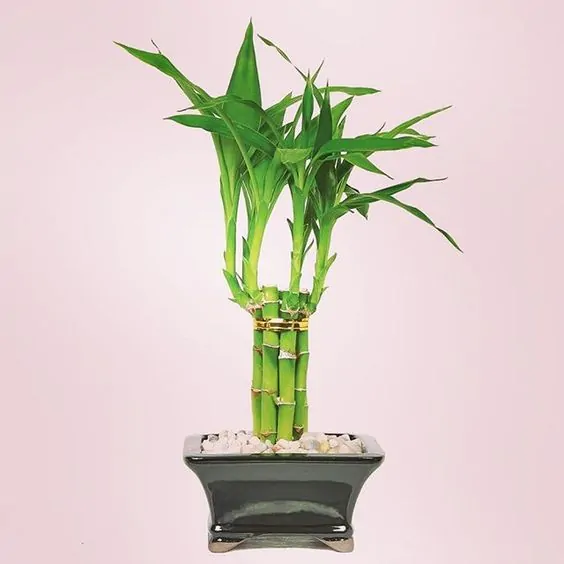
Lucky Bamboo is mainly seen as a houseplant that can grow in water.
Technically not a true bamboo, it only needs bright indirect light. If you are going to grow it in water, make sure to change it once a month or so.
In its natural habitat, Lucky Bamboo can reach up to eight feet in height. However, don’t expect it to reach much past four feet indoors.
Source: marikalemieux on Instagram
Most people think of pointy sharp leaves when they hear the word Yucca.
The common name for this cultivar is “Stick Yucca” or “Spineless Yucca.” While the very ends of the wide sword-shaped leaves can be pointy, they are not as stiff as the typical yucca.
Additionally, when it comes to growing requirements, this one will take as much light as you can give it. So, lower light conditions will make it grow slower. For more information about Yucca trees, check out our guide on how to grow and care for indoor and outdoor Yucca!
Source: craziestplantlady on Instagram
The Chinese fan palm is a staple in the southern landscape scene but has come about as a tough indoor tree as well. It has a single trunk that produces fountain-like foliage at the top that drops down.
Able to reach heights of 20-30 feet, it rarely gets that big indoors. Not to mention, this palm is exceptionally drought tolerant and will thrive on some neglect.
Source: modernflorae on Instagram
This cactus does exceptionally well in containers. With its spreading arm growth habit, giving it the look of a candelabra, it can attain heights of 8-10 feet tall and 5 feet wide, so give it plenty of room. If you want to learn more about growing cacti and succulents indoor, make sure you check out our tutorial!
It does have sharp thorns on the sides of the branches, so keep that in mind with pets and children. Being a cactus, it can go weeks without water. Low light levels will cause it to grow slower and reach for the light, giving it a slightly spindly appearance.
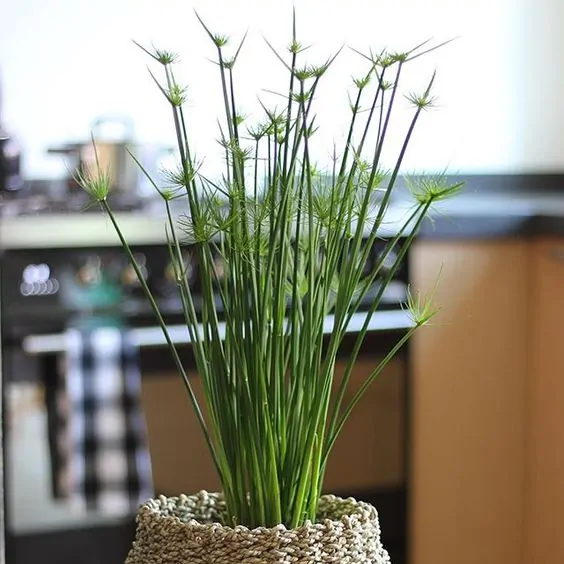
Source: hortology on Instagram
Even though this is technically grass, anything that can reach six feet tall may as well be considered a small tree. Like many of the papyrus, it’s practically impossible to kill it by overwatering.
Also, the Egyptian Papyrus is also a fast-growing plant and tolerates low light levels. However, it’s not very drought tolerant.
Source: doma.home.decor on Instagram
The New Zealand Laurel is a slow-growing tree with 6 to 8 inches long, oblong leathery leaves and upright growth habit. It’s a perfect tree for any large indoor space.
This tree prefers bright indirect light and likes to stay moist. However, it will tolerate the occasionally missed waterings. It may produce fruit indoors, and while the fruit itself is edible, the seed contained inside is extremely poisonous.
Source: filpusni on Instagram
This palm will buck the trend slightly as it does not do well in a pot indoors unless it is a very deep pot.
It’s very similar to the Kentia Palm, but it has a few differences. The potting situation has already been mentioned. Another difference is that the Sentry palm tends to have more curved leaves with erect leaflets.
Bright indirect light and moist soil are the only other things this palm needs.
Source: nataliemiller24 on Instagram
As you can imagine by the name, the Pygmy Date Palm is relatively small, keeping itself at 6-10 feet tall at maturity.
It is one of the most widely used palms in the interiorscape industry, and it will need as much light as you can offer, only tolerating light shade.
The Pygmy Palm prefers moist, rich potting soil to truly thrive, but will tolerate some drought.
Source: 2blueteam_ltd on Instagram
This palm goes by multiple other names such as Areca Palm and the Golden Cane Palm. It is one of the most common from this palm family and easier to grow. The butterfly palm is easily killed by overwatering so if you forget to water it, often, it will not mind.
The’s one issue this palm has: if the temperature fluctuates too widely, it may throw its leaves to the ground in protest. Bright indirect light and no full sun will keep this palm happy.
Source: shanti_love10 on Instagram
Another of the most common indoor palm trees, the Cat Palm will reach heights of six feet. It will tolerate some low light conditions but prefers brighter accommodations.
Moist soil and the occasional misting or keeping it near the bathroom will help with its need for 50% or more humidity.
It does grow in clumps but dividing them as they get bigger is not advised because the roots are very fragile.
Source: wellswoodhomes on Instagram
Yes, just like in Italy, you can grow an Olive Tree indoors.
The caveat is, the tree will not be able to survive there forever, usually 9-10 years max. Thanks to the fact that it comes from a Mediterranean climate, the olive tree is well suited for the drier humidity found in most homes.
They will need as much sunlight as you can give them and will prefer to dry out a tad between watering. As for actually producing olives, if you get a dwarf version and place it outside during the summer, the chances are good.
Source: pietro_valdes on Instagram
If you’ve ever been to Hawaii or at least worn a Lei around your neck, you probably are familiar with Plumeria.
It’s considered a tropical plant, so keeping the temperature above 65 degrees is recommended. A constantly moist soil through the growing season is also required. However, if the temperature drops suddenly it can go dormant and drop its leaves.
For those interested in tropical plants, we recommend this Chinese Hibiscus plant care guide to help you grow a tropical garden in your own home.
Source: hegyi.viktoria on Instagram
Another palm that does very well in the landscape of the southern states but does equally as well as a potted indoor tree.
The European Fan Palm is a slow-growing, clumping palm that will max out at 10-15 feet tall outdoors. However, it can hardly reach more than 4 feet indoors.
It is also drought tolerant and will take as much light as you can give it.
Source: leonandgeorge on Instagram
Like many of the other fig or ficus plants on our best indoor trees list, the Triangle Fig is very forgiving about indoor accommodations.
Maturing at eight feet tall and having unusual triangle-shaped leaves makes this tree an ideal candidate for your living room.
Source: thebristolrainforest on Instagram
The Sacred Fig is believed to have religious significance in three major religions, Hinduism, Buddhism, and Jainism.
This sacred tree is a fast grower, and it has an extremely long life span. A 900+ years tree can achieve 95+ feet tall.
The sacred fig is very adaptable to any degree of light, except very low light. Moist soil to drought conditions doesn’t affect it. More times than not, it makes a perfect bonsai project.
Before we wrap up this guide on the best indoor trees to host at home, why don’t we answer some of the most frequently asked questions about them?
Some of the most low-light tolerant indoor trees and plants are as follows:
A potted olive tree thrives in a mix of rich potting soil with small rocks or perlite. You should opt for clay or wood containers. We don’t recommend plastic pots or containers for olive trees as plastic pots retain water and it can be deadly for olive trees. We also recommend six hours of sunlight for a beautiful and plentiful olive tree.
Just like any plant, indoor trees have a few requirements that you need to adapt to each type and variety. Overall, you need to consider:
Some plants and trees also thrive if you talk to them nicely and with affection. Other plants and trees love different music genres and styles. Before you start growing and grooming a houseplant or a tree, learn what other caring tips to employ to keep it happy!
If you have big spacey rooms and want to fill them in with some nature, then consider any of these indoor trees. They produce oxygen and help clean the air, inside and outside, so why not take advantage of that?
Did we miss one of your favorite best indoor trees? Let us know by leaving a comment below!

Monthly updates on your favorite plants and how to keep them alive, delivered straight to your inbox!
Privacy Policy
This privacy policy outlines what info we gather from our visitors and contributors, the tools we use to collect, store, and protect it, and how we use this information.
Like any other website on the World Wide Web, YouHadMeAtGardening.com records some info about you and your device during your visit. This privacy policy outlines how our team gathers, stores, protects, and uses the information it gathers from visitors of the YouHadMeAtGardening.com website.
By continuing to use this website, you implicitly agree to this policy; if you do not agree to some or all of the procedures listed on this page, you can opt out at any time, however, you might not enjoy the intended browsing experience.
Our team reserves the right to alter this privacy policy with no prior notice to you. However, if the alterations made affect your personal data in any way, you will be notified immediately by email, on our homepage, or here.
Information YouHadMeAtGardening.com Collects
Our systems gather personally and non-personally identifiable information from visitors of the YouHadMeAtGardening.com website.
The only personally identifiable information we collect is your name and e-mail address only when leaving comments if you’re a visitor, or when submitting content and leaving comments, if you’re a contributor.
However, if you are not comfortable with providing your personally identifiable information to us, you can also use an alias instead of your real name and e-mail address without breaking any rules or regulations currently in use.
Note: If you submitted a comment using your personally-identifiable information and want it removed, you can always contact us and we will remove your info in 30 days.
The non-personally identifiable information we collect is your IP address, ISP information, device and browser info, and your browsing patterns – specifically the pages and websites you visit. This information cannot be used to track down your identity.
How We Collect Your Information
We use the following tools to gather personally and non-personally identifiable information from visitors and contributors:
• Cookies: these tiny text documents contain unique identifiers that are stored in your computer after your expressed consent. Cookies collect non-personally-identifiable information about your browsing patterns, which helps us pinpoint the areas of our website that require extra work and the areas that fully meet your needs.
• Log files: These tools record browser and device information, browsing patterns, websites that referred you to the YouHadMeAtGardening.com website, pages our website referred you to, and other types of non-personally identifiable information.
• Sign-up forms: these requests only come up when registering for our newsletter and is the only way our team collects personally-identifiable information from visitors.
How We Protect Your Information
All information we gather, both personally and non-personally identifiable, is stored in systems and databases managed only by the YouHadMeAtGardening.com team. We use the latest security measures to make sure the information you provide and the information we gather stays confidential, such as encryption, user behavior monitoring, and a series of managerial procedures.
How We Use Your Information
We only use your personally and non-personally identifiable information to improve the quality of the website and your browsing experience while here. We want to know which pages and sections of our website satisfy your needs and are of real value to you and which ones need improvement so we can make the proper adjustments. We also use your information to make sure the website is properly displayed on your device and browser.
If you choose to opt in for our newsletter, we will also use your information to keep in touch.
However, know that the YouHadMeAtGardening.com team will never share your information with other parties in exchange for financial rewards or any other kind of benefits. Some third parties might get very limited access to your info, but only to your non-personally identifiable information and only as we described above.
The personally identifiable information you provide is strictly confidential, therefore we will not share it with anyone.
Advertising
This Site is affiliated with CMI Marketing, Inc., d/b/a CafeMedia (“CafeMedia”) for the purposes of placing advertising on the Site, and CafeMedia will collect and use certain data for advertising purposes. To learn more about CafeMedia’s data usage, click here: www.cafemedia.com/publisher-advertising-privacy-policy
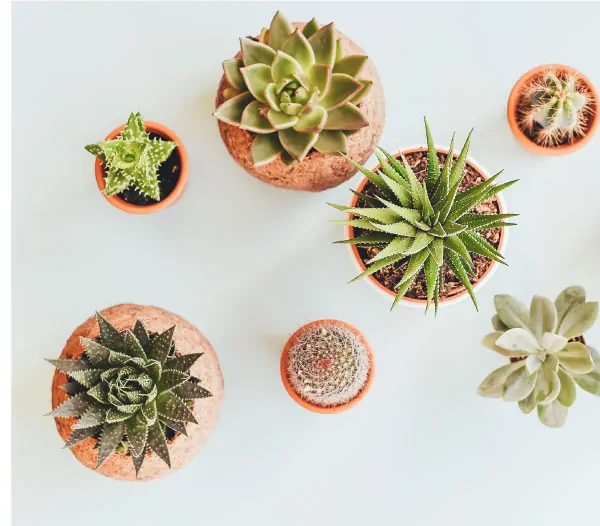
This plant requires medium to low light and only needs to be watered when the top of the soil is dry. Juxtapose the organic shape of the leaves with a modern planter like this DIY option from Pretty Nice .